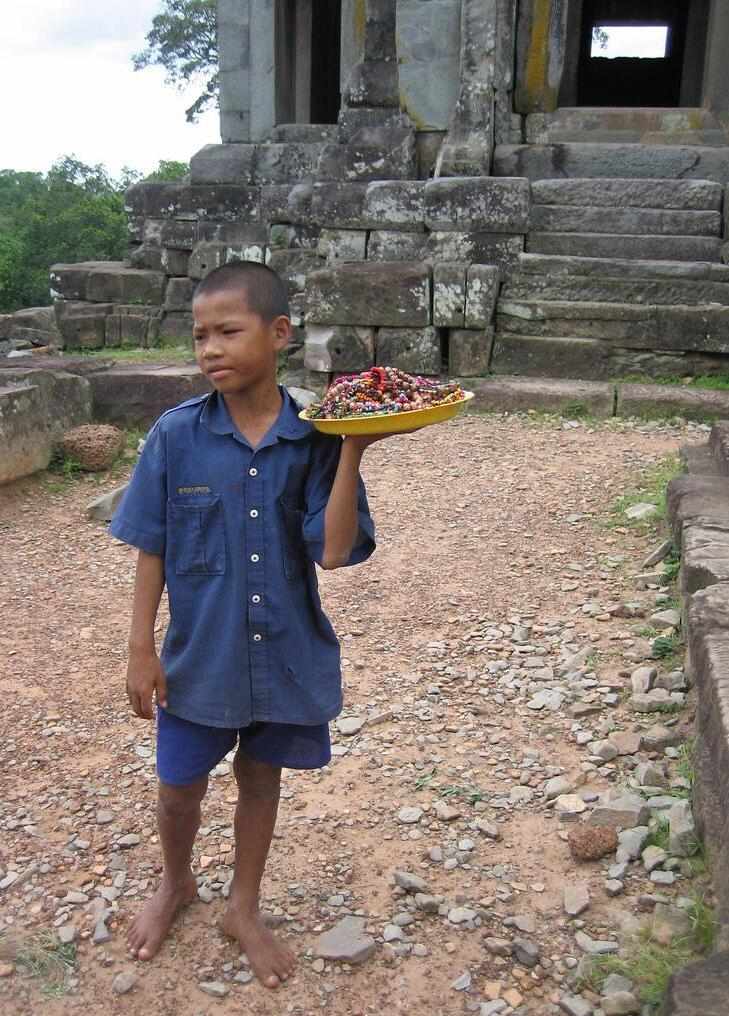
Cambodian History: Kymer Empire (6th-13th century AD)

Figure 1.-- The most notable remanent of the Kymer Empire is Angkor Wat. This is a temple complex at Angkor in western Cambodia near the Thai border. This photo was taken at Angkor Wat, the most important Cambodian temple complex. The boy is selling bracelets and necklaces to tourists."
|
|
A destinctive new Kymer culture began to rise (6th century). Jayavarman II, a Khmer prince, founded a new kingdom (9th century AD). Prince Jayavarman seceded from the Chenla Kingdom. Strongly influenced by India and Hinduism, he founded a cult that centered on Shiva. Jayavarman declared himself a devaraja (god-king), linking himself to Shiva. Jayavarman ininiated a vast building program, including both architecture and sculpture. Jayavarman and his successors constructed a vast irrigation system around Angkor. This led to a huge increase in agricultural production which richly supported the developing Kymer Empire (9th-15th centuries). The Kymer Empire expanded into much of Southeast Asia (Thailand, Laos, Myanmar and Malaysia). The Khmer Empire developed into the largest continuous Southeast Asian empire. There were varying cultural, political, and trade relations with Java, and subsequently with the Srivijaya empire to the south. Despite the importance of the Kymer Empire and existence over several centuries, there are no surviving Kymer manusdcripts. According to the Chinese scholsr Zhou Daguan in the Chinese annals, the ancient Khmers wrote on on latina leaves. They alson used chalks on the animal's skin. There must have been a considerable literature. Tragically, all Kymer manuscripts appear have decayed or otherwise deteriorated since the decline of the Empire. The rainy, moist tropical climate and insects appear to have almost totally destroyerd their literature. Thus the Kymer languasge is only known through stone temple carvings and is thus mostly religious and philosophical. Archeologists have found about 1,200 stone inscriptions written in Sanskrit and Khmer. Many Angkor temples have inscriptions in both languages - Sanskrit and Khmer. The most notable remanent of the Kymer Empire is Angkor Wat. This is a temple complex at Angkor in western Cambodia near the Thai border. It was built for king Suryavarman II (early 12th century). It was the state temple at the center of his capital city. There may be as many as 1,000 temples there, many with inscriptions of historical importance. It is the only Kymer site to have remained an important religious center since its foundation. At first it was used by Hindus and dedicated to the god Vishnu. It was subsequently after the Kymer era used by Buddhist. The temple is an example of the high classical style of Khmer architecture. It is a symbol of modern Cambodia and is depicted on the national flag. The power of the Kymer Empire began to decline (13th century). As the only surviving historical writings are temple inscriptions, the reason for this decline are not fully understood. There are various theories, including the increasing military power of Thai kings, the rise of Theravada Buddhism, and enviromental changes reducing the productivity of irrigated rice raising areas around Angkor.
CIH

Navigate the Children in History Website:
[Return to the Main Cambodian history page]
[Return to the Main Asian history page]
[Introduction]
[Animals]
[Biographies]
[Chronology]
[Climatology]
[Clothing]
[Disease and Health]
[Economics]
[Ethnicity]
[Geography]
[History]
[Human Nature]
[Law]
[Nationalism]
[Presidents]
[Religion]
[Royalty]
[Science]
[Social Class]
[Bibliographies]
[Contributions]
[FAQs]
[Glossaries]
[Images]
[Links]
[Registration]
[Tools]
[Children in History Home]
Navigate the Boys' Historical Clothing national pages:
[Return to the Main Cambodian page]
[Return to the Main Asian page]
[Afghanistan]
[Bhutan]
[China]
[India]
[Pakistan]
[Sri Lanka]
[Tajikistan]
[Turkmenistan]
[Uzbeckistan]
Created: 7:27 AM 12/2/2010
Last updated: 5:18 AM 2/16/2015



